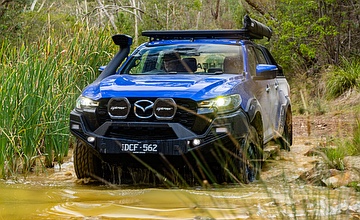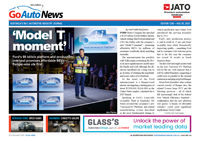Make / Model Search
OptionsCar reviews - Mazda - BT-50 - GTMazda modelsOverviewWe like External styling continues to impress; low-end torque extremely useful off-road; cabin feels more spacious than some competitors Room for improvement Throttle lag an issue on-road; ride refinement and NVH trail best in class; infotainment and ADAS niggles remain a letdown Recently updated BT-50 adds worthwhile changes to popular go-anywhere workhorse21 May 2025 By MATT BROGAN Overview
MAZDA recently updated its faithful BT-50 workhorse with significant styling changes aimed at bringing the model’s looks in line with to those of its SUV siblings.
The changes saw a new frontal mask, LED headlighting, a ridged tailgate, and larger Mazda logos adopted alongside minor technical changes including a revised 8.0-inch infotainment array (9.0 inches on XTR grades and higher) and updated 7.0-inch multi-information display touchscreen.
Importantly, the revision also introduced improved safety technologies encompassing wide-view stereoscopic cameras to enhance the BT-50’s lane-assist, adaptive cruise control, and autonomous emergency braking abilities, the latter gaining motorcycle detection for the first time.
Mechanically the BT-50 is unchanged, continuing with its turbocharged 3.0-litre four-cylinder diesel now backed exclusively with a six-speed automatic transmission. Power and torque outputs remain at 140kW/450Nm while combined cycle fuel consumption is listed at an optimistic 8.0 litres per 100km.
In keeping up with the class average, Mazda continues to offer the BT-50 with a braked towing capacity of 3500kg and payload of 998kg. GVM tops out at 3100kg and GCM 6000kg, and you can use Mazda’s nifty payload calculator to determine how much payload you can legally carry when travelling with a trailer on the back.
On test is the penultimate BT-50 GT (from $66,170 plus on-road costs).
Offered in dual-cab format only, and with part-time four-wheel drive, the variant adds niceties like heated wing mirrors, leather upholstery, eight-way electric driver seat adjustment, front seat heating, remote engine start functionality, and front parking sensors.
The example on test was further accessorised with a hoopless steel bullbar, snorkel, driving lights, roof platform, awning, SP accessory wheels with A/T tyres, rubber floor mats, UHF radio, black fender flares, sports bar, and a lockable manual roller cover.
Paint colours across the range include Concrete Grey Mica, Geode White Pearl, Ice White Solid, Ingot Silver Metallic, Red Earth Metallic, Sailing Blue Metallic (pictured), and True Black Mica.
Like all BT-50 grades the GT is equipped with Lane Keep Assist System (LAS), Blind Spot Monitoring (BSM), Rear Cross Traffic Alert and Braking, Traffic Sign Recognition, and Trailer Sway Control (TSC). Eight airbags are standard, including a driver’s knee- and centre airbag between the front seat occupants.
It further offers both ISOFIX and top-tether child-seat anchorages in the usual positions.
Mazda backs the BT-50 with a five-year/unlimited-kilometre warranty for both private and commercial buyers which also covers any Mazda-fitted accessories. Roadside assistance is included for five years and capped-price servicing for seven years.
Service intervals are set at 12 months or 15,000km (whichever comes first) with scheduled maintenance totalling $2498 over a typical five-year ownership period.
Driving Impressions
When borrowing the BT-50, Mazda Australia explicitly told us to “give it heaps”, even plastering its new advertising slogan across the loaner vehicle’s back window. With encouragement like that, give it heaps we did, setting directly for some of the tougher trails of the Lerderderg State Forest.
The heavily accessorised GT variant proved understandably noisy on the open road, the all-terrain tyres, roof racks, awning, bullbar, and snorkel also doing their utmost to add to our fuel bill.
Unfortunately, Mazda’s (and by extension Isuzu’s) uptight driver assistance technologies also made their presence known, panicking at the proximity of other vehicles to the BT-50, and the BT-50 to its position within the lane. While some of this can be put down to poorer line markings, it is still a disappointment to experience such nervousness when Mazda claims to have addressed the issue.
We ended up switching the offending driver aids off and continued on our way, enjoying the spacious cabin and sorted ergonomics the BT-50 provides in spades.
Visibility from the driver’s pew is excellent, the level of adjustment on offer further allowing that Goldilocks position to be easily found when seated behind the ‘wheel. There is also a decent amount of storage around the cabin, helping to tuck camera equipment, drink bottles and the like where they’re held with some security. Unfortunately, however, there is no wireless charging pad meaning we still had the requisite cables draped across the console for the charging of mobile phones, etc.
Up back, the seats are as comfortable as you should expect from a dual-cab ute, the semi-stadium-style arrangement allowing a good view out, but perhaps at the cost of a little headroom. Pleasantly, there are air vents and USB-C charging ports at the rear of the centre console, along with door bin and armrest storage for drinks and smaller items.
Further back still, the BT-50 offers a carpeted tub with a lockable roller cover, and a handful of tie-down points. However, there are no lights back here for after-hours work, no power outlets, and no dust sealing… look at the images attached to see just how much dust filled the tray bed after just an hour or two off road.
But it’s here, off road, that the BT-50 feels absolutely in its element. Clearance is perhaps the only letdown in what is a capable and no-nonsense off-road chassis package that is well tuned to tackle the worst our test loop could throw at it.
The BT-50, like myriad other dual-cab utes, runs a coil sprung independent front and leaf-sprung live axle rear arrangement we feel offers decent compliance, even with a very light load on board. Add a couple of hundred kegs of firewood and fenceposts and there’s no reason it shouldn’t settle into an even more comfortable ride.
Grabbing low range – and with occasional assistance from the rear differential lock and/or Rough Terrain mode – we found progress over the gnarly stuff smooth and steady, the traction control stepping in nice and early to ensure minimal traction loss, which is particularly handy when crawling over rock or climbing shaly surfaces.
Isuzu’s 4J-series engine offers ample torque from just above idle, allowing the driveline and traction systems to get the job done with very little fuss. It’s interesting that the throttle lag experienced on-road is very hard to detect in slower going, the engine no doubt assisted by the additional torque on offer in transferring into low range.
On paper, the BT-50 might seem behind its peppier competitors, but we reckon there’s plenty of grunt for work in the rough stuff, even if it comes with a bit of rattle and clamour when asked to break a sweat.
The Aisin-sourced six-speed automatic (also found in the Isuzu D-Max, Mitsubishi Triton, and Toyota HiLux) is calibrated rather well, and requires little in the way of manual intervention. At higher speeds, however, it can be a little busy, unnecessarily selecting lower ratios when ascending or descending grades.
It’s an issue that seems to be something of a trait of the AWR6-series transmission and is more pronounced in some makes and models than it is in others. Being an owner of this transmission myself, I can say that it gets better as it ‘learns’ and adapts to the way you drive, something the BT-50 loaner has unlikely had the chance to achieve.
Elsewhere, we note a steering rack that borders on the weightier end of the scale, and that is also quite slow in reacting to the driver’s input. We found wheel work a little busier than in other rivals, comparing the BT-50 more closely with the Mitsubishi Triton than the Toyota HiLux in this respect.
The BT-50 offers a turning circle of 12.5m, which runs toward the larger end of its competitor set, but is still manoeuvrable enough in the tighter tracks we encountered – and when parking at the supermarket later on.
Perhaps disappointingly, the BT-50’s brake pedal stroke leaves a lot to be desired. There’s a lot of pedal travel before any braking action occurs, taking much of the progression favoured in off-road driving out of the driver’s hands (well, feet… you know what I mean). The four-wheel discs are otherwise sufficient for the task at hand, even if the park brake adjustment of our test car was well and truly out of limits.
On the drive back to town we were pleased to find the BT-50 no worse for wear than when we started. Besides being a little dirtier than before, there were no rattles or squeaks to report, the driveline too settling back into a steady rhythm for the highway stretch back home.
A flick through the half-analogue/half-digital instrumentation panel saw a 10.5-litre result on the fuel screen, meaning the BT-50 should be capable of returning a theoretical driving range of 720km from a single fill. It’s not the worst we’ve seen from a dual-cab ute, but far from the best either – which sums up the position of the Mazda offering nicely, really.
This is a middle-of-the-road ute that feels as honest as they day is long, and while it certainly doesn’t have the polish and pizzaz found in the Ford Ranger and Volkswagen Amarok twins – or the extra grunt on tap in the Toyota HiLux – it is a very capable and good-looking workhorse that offers most of what dual-cab buyers expect, and with the warranty and aftersales support Australian buyers demand.  Read more5th of May 2025  Mazda CX-60 priced from $50,240Updated 2025 Mazda CX-60 SUV to launch with special introductory pricing, new grades24th of April 2025  Proven MX-5 formula to carry on: reportNext-gen Mazda MX-5 to remain lightweight, with 2.5-litre petrol power, manual transmission11th of March 2025  New front-drive grade for Mazda CX-5Mazda CX-5 G25 Touring FWD joins updated 2025 range from JuneAll car reviews Alfa Romeo Alfa Romeo Abarth Abarth Audi Audi Aston Martin Aston Martin BMW BMW Bentley Bentley Chrysler Chrysler Chevrolet Chevrolet Dodge Dodge Citroen Citroen Ferrari Ferrari DS DS Ford Ford Fiat Fiat FPV FPV Foton Foton Haval Haval Great Wall Great Wall Honda Honda Holden Holden Hyundai Hyundai HSV HSV Isuzu Isuzu Infiniti Infiniti Jaguar Jaguar Iveco Iveco Kia Kia Jeep Jeep Land Rover Land Rover Lamborghini Lamborghini Maserati Maserati Lexus Lexus McLaren McLaren Mazda Mazda Mercedes-Benz Mercedes-Benz Mitsubishi Mitsubishi Mini Mini Opel Opel Nissan Nissan Porsche Porsche Peugeot Peugeot Ram Ram Proton Proton Rolls-Royce Rolls-Royce Renault Renault Skoda Skoda Saab Saab SsangYong SsangYong Smart Smart Suzuki Suzuki Subaru Subaru Toyota Toyota Tesla Tesla Volvo Volvo |
OptionsClick to share
|











Facebook Twitter Instagram